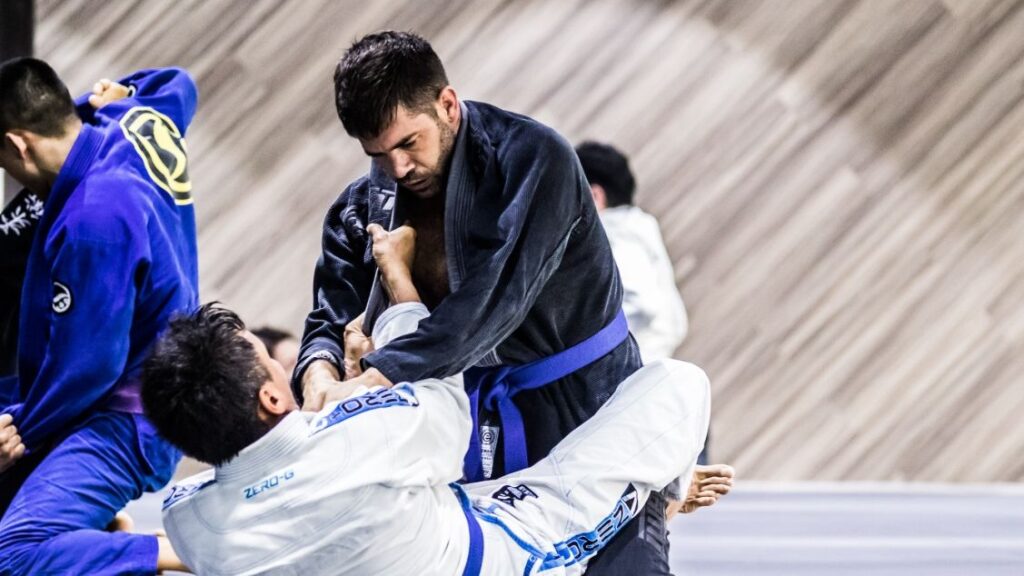One of the major differences between Brazilian Jiu-Jitsu (BJJ) and no-gi grappling is the ability to grip the fabric of an opponent’s gi. Grips change the game so much, in fact, that grapplers unfamiliar with the gi often have a difficult time adjusting to them during their initial forays into BJJ. This is primarily due to the fact that many BJJ techniques involve gripping and manipulating the gi in order to control, sweep, and submit one’s opponent. No-gi grapplers, on the other hand, rely primarily on leg entanglements and wrist control to execute their techniques. Needless to say, grip fighting is an important part of BJJ. Therefore, it is imperative that BJJ students understand how to defend against and break an opponent’s grips. At the highest levels of BJJ and judo competition, the opponent who is first able to secure effective grips significantly increases his or her chances of victory. Unfortunately, however, many BJJ students fail to practice this skill. Below are some important concepts and techniques related to breaking grips in BJJ.
Concepts and techniques
Even if you don’t yet know any specific grip-breaking techniques, there is an easy concept to keep in mind that should allow you to safely escape most situations in which your opponent has established grips on your gi — the two-on-one matchup. When your opponent has gripped your gi with one hand, using two hands to attempt to break his grip will greatly increase your odds of success. This is due to the simple fact that your two hands are almost always going to be stronger than your opponent’s one hand. Therefore, any time your opponent grabs your gi with a single hand, establishing a two-on-one grip is usually a good option to begin breaking his grip. Below are a few effective grip-breaking techniques, some of which incorporate this concept.
Technique 1
- Grab your opponent’s sleeve with a two-on-one grip.
- Push your opponent’s hand away from your gi at a 45-degree angle. As you perform this movement, be sure to do so explosively while maintaining good posture and moving your body in the opposite direction of your hands. This should release his grip.
- Continue to maintain your grip while pushing your opponent’s hand down and away from your body.
Technique 2
- If your opponent establishes a grip on the sleeve of your power hand (if your right foot is forward, your power hand is your left hand), bend your arm at the elbow, and bring your thumb toward your shoulder. This should remove the slack from your sleeve.
- Lift your elbow and pull your arm away from your opponent and towards your back.
- As you pull your arm away from your opponent, his grip should release.
Technique 3
- If your opponent establishes a grip on the sleeve of your power hand, bend your arm at the elbow, and bring your thumb toward your shoulder. This should remove the slack from your sleeve.
- Circle your thumb to the outside of your opponent’s wrist. Make a circle with your thumb as you do this.
- Lift your thumb up, and bring it toward your ear.
- Explosively pull away from your opponent. This should release his grip.
Technique 4
- If your opponent establishes a grip on the sleeve of your power hand, arch your hand backwards, grabbing your opponent’s wrist.
- Push down on your opponent’s wrist as you straighten and round your back. This should release his grip.
- Push your opponent’s wrist as far from your body as possible.
Technique 5
- If your opponent establishes a grip on the sleeve of your lead hand, take your power hand and place it on top of his wrist.
- Straighten your arm while extending your power hand downward.
- Your opponent’s power hand should catch on his sleeve arm. This should break his grip.
Drilling
Drilling should be incorporated into every BJJ’s student’s training routine. By practicing techniques repeatedly, BJJ students build muscle memory that enables them to effortlessly execute sweeps, submissions, takedowns, and other techniques during live rolling and competition. Therefore, drills for both breaking and establishing grips should be practiced regularly by all BJJ practitioners. An excellent partner drill in which both aspects of the grip game can be practiced is described below. Practicing this drill repeatedly will instill the importance of breaking an opponent’s grip as soon as it is established.
- Facing one another, both partners should establish a strong sleeve and collar grip on the other.
- One partner should then establish a two-on-one grip on the other’s collar.
- With a two-on-one grip established, the partner should then break the other’s collar grip and reestablish a sleeve and collar grip.
- Back to their original position, the second partner should repeat steps two and three.
- Both partners should repeat this sequence several times.
Become a Master of Grips!
Are your training partners and opponents frequently able to establish grips on you before you’re able to do the same? Understanding how to break your opponent’s grips (especially bigger, stronger opponents) is an essential skill to master in BJJ. In addition, the ability to establish your own grips on an opponent before he is able to do the same to you is a skill that should not be neglected. Begin incorporating the above concepts, techniques, and drills into your training routine, and you’ll soon be a master of the grip game!
If you found this article interesting, here are some others that you may enjoy:
5 BJJ Submission Chains Worth Learning

















